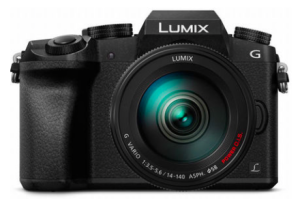Panasonic Lumix G7 First Impressions
There are many competitive options in the marketplace when it comes to buying a camera. The more traditional DSLR-style cameras from Canon and Nikon have dominated the market but we are now seeing Mirrorless Cameras from Sony and Fuji win over loyal users with their features and form factor.
An option that is often overlooked by photo and video enthusiast is the Micro-Four-Thirds (MTF) cameras from Panasonic and Olympus.
Recently I made the decision to upgrade from my Nikon DSLR. Primarily I use my camera for video, and I’m traveling to conferences almost every month now, as well as taking personal trips. I needed something lightweight and practical. I wanted to have options like 4K Video, which ruled out most DSLR cameras currently available at a reasonable price point.
The Sony Mirrorless cameras like the new A6300 and the A7S II just didn’t seem like the fit what I’m doing at the moment and seemed a bit pricey with that in mind.
Ultimately I chose the Panasonic Lumix G7 since I had an opportunity to try it out at ShutterFest and learn quite a bit about the camera beforehand.

At about $600 on Amazon including the kit lens, I was surprised how much value the camera had to offer with its core features:
- 4K Video at 24FPS and 30FPS
- 1080P Video at 24FPS, 30FPS and 60FPS
- Flip-screen with touch capabilities
- 16MP Live MOS Sensor
- 4K Photo Mode
- Up to 8FPS Burst Shooting
- Built-in WiFi Connectivity
That is quite a bargain when you consider how much you’d pay for those features in a DSLR or MSLR. It led me to ask the question, why aren’t more people recommending this camera?
The majority of camera enthusiasts are coming from the world of traditional cameras built on 35mm film technology. It is why professional photographers prefer “Full Frame Cameras” vs. “Crop Sensor Cameras.” To help put this into context, a professional photographer will tend to favor a camera like the Nikon D810 or Canon 5D Mark III. These cameras are great, but have features the typical user won’t often take advantage of, and they cost upwards of $2000, not including professional lenses, which tend to cost almost as much.
They have many advantages regarding image quality, durability and are flexible in almost any situation. We have seen stunning professional pictures captured by something as simple as the iPhone 6s.
At the end of the day, I knew I was buying this camera, not as a photographer, but as a videographer, business owner and filmmaking enthusiast, which meant it was perfect for me.
Why Micro-Four-Thirds Cameras Are Underestimated
In feature length films 35mm cameras were the standard; which is why professional videographers and photographers have their established preferences. However, back in the old days of film, 16mm was a standard as well for shooting news footage and documentaries rather than features. This is where the MTF system comes into play. With the smaller sensor, it is true that you have lower overall image quality than a larger camera system, but it is nowhere near unusable and is still superior to the image quality the camera in the best smartphone can produce. MTF cameras have a sensor size that is closer to the Super 16mm widescreen film format that independent films were shot on, and that has made it popular for those types of projects today.

Shot on the Panasonic Lumix G7
My Favorite Features of the Panasonic Lumix G7
One of the things that attracted me to the Panasonic G7 was the fact that it utilizes Leica lens optics and that they were made purely for digital photography and video. The traditional DSLRs and their lenses are a bit dated as far as technology. The Panasonic system provides an almost perfect silent autofocus for video, which is a great feature when shooting events.
The option to shoot 4K video and 4K photos are something that appeals to me. I like having the option to utilize them or to crop in. Most people make the argument that 4K isn’t being consumed by the majority of the market, but I like being prepared for standard shifts and there is no real downside to learning 4K standards and workflows.
4K Video Sample Test of the Panasonic Lumix G7
Who is the Panasonic Lumix G7 For?
Honestly, I feel that this camera would suit most people. It has great image quality, is not very complicated to use and has a ton of great features you could grow to love over time.
Even with a lens this camera only weighs a little bit more than my iPad Air2 and takes up very little space. It also is a 4K video camera for a very reasonable price, and while that may not matter as much to people right now, it does mean that the camera will not be outdated anytime soon.
If lightweight and portability are priorities for you, and you like the idea of having great video features in addition to stunning photos, this camera would be a good fit for you.



